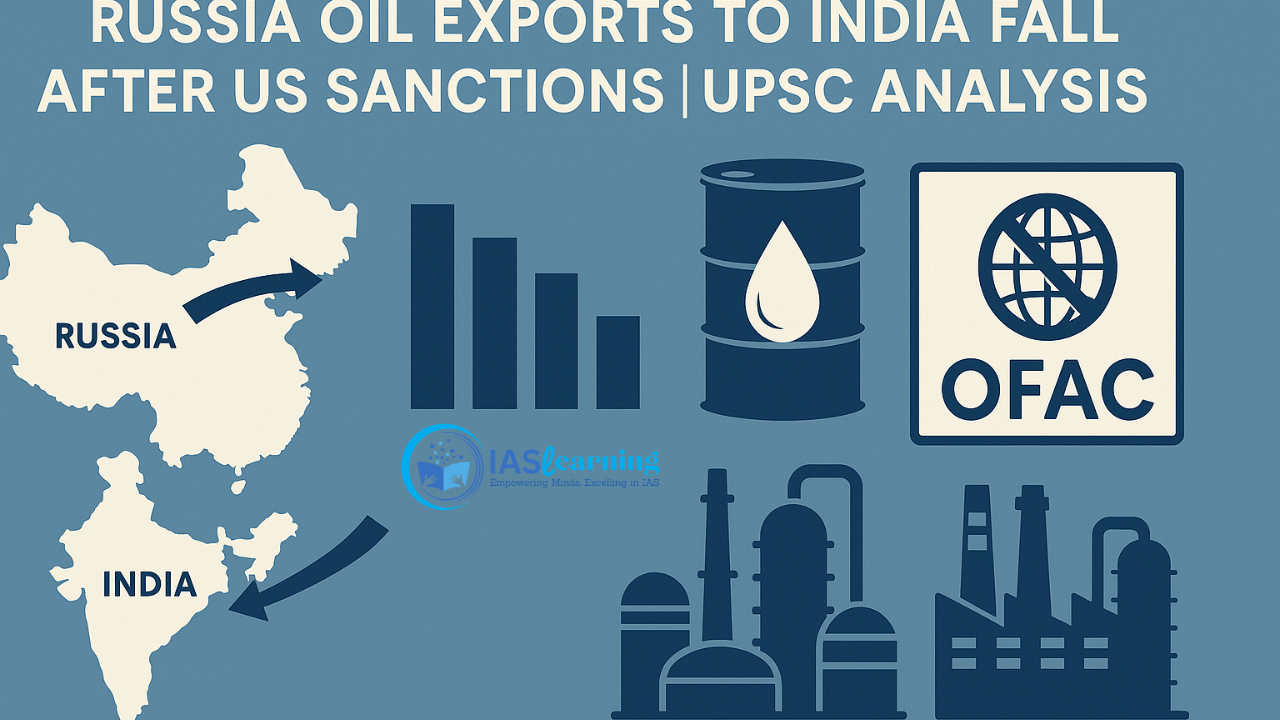🗞️ Context: Russia Oil Exports to India
In a sharp reversal of trends seen since 2022, Russia’s crude oil exports to India have fallen dramatically following new US sanctions on Russian oil majors — Rosneft and Lukoil.
According to global data provider Kpler, Russian exports to India dropped to 1.19 million barrels per day (bpd) in the week ending October 27, 2025, down from 1.95 million bpd earlier.
This marks the first major decline since India became Russia’s largest oil buyer after China, driven by discounted crude amid Western sanctions following the Ukraine conflict.
🧭 Background: India-Russia Oil Trade
- Since 2022, India has emerged as a top importer of Russian crude, taking advantage of heavy discounts post-Ukraine war.
- Russian oil accounted for around 35% of India’s total crude imports in 2025.
- India’s refiners — Reliance Industries (RIL), Indian Oil (IOC), HPCL-Mittal Energy, and Nayara Energy — have been major buyers.
However, the US Department of Treasury’s Office of Foreign Assets Control (OFAC) sanctioned Rosneft and Lukoil on October 22, 2025, triggering compliance reviews among Indian refiners.
Also Read: Extreme Cold Expected in India: Understanding the “La Niña
⚖️ Understanding the New US Sanctions
- The sanctions target Russia’s two biggest state-run energy giants:
- Rosneft – contributes nearly half of Russia’s total crude exports.
- Lukoil – Russia’s largest private oil company.
- These sanctions prohibit transactions with US citizens or entities and impose secondary sanctions on foreign firms dealing with the targeted companies.
- The deadline for winding up all dealings is November 21, 2025.
🛢️ Impact on India’s Oil Imports
📉 Immediate Decline in Exports
- Rosneft’s supplies to India plunged from 1.41 million bpd (previous week) to 0.81 million bpd (October 27 week).
- Lukoil’s shipments dropped to zero, compared to 0.24 million bpd a week earlier.
⚠️ Refiners’ Reactions
- HPCL-Mittal Energy (HMEL) suspended Russian imports.
- IOC stated it would comply with all global sanctions.
- Reliance Industries, India’s largest refiner, said it is assessing implications and will ensure “full compliance.”
🏦 Why Such Caution?
The risk of secondary sanctions means that even non-US companies could face restrictions on:
- Dollar-based transactions
- Access to American financial systems
- International banking networks
Hence, Indian refiners and banks are avoiding exposure ahead of the November 21 deadline.
Also Read:Air Pollution in India – Causes, AQI & UPSC Notes
🌍 How US Sanctions Work
| Type of Sanction | Definition | Impact |
|---|---|---|
| Primary Sanctions | Restrict US persons/entities from trade with targeted entities | Applies directly to US companies |
| Secondary Sanctions | Restrict non-US entities that engage with sanctioned companies | Global ripple effect |
OFAC (Office of Foreign Assets Control) administers and enforces these sanctions under US Treasury jurisdiction.
📊 Data Snapshot (October 2025)
| Parameter | Value |
|---|---|
| Russia’s share in India’s oil imports | ~35% |
| Russian oil imports in October | 1.62 million bpd |
| Share of Rosneft & Lukoil | >60% of Russian oil imports |
| Expected reduction post-Nov 21 | 30–40% drop |
| India’s oil import dependency | 88% |
🔁 Shift in Energy Supply Strategy
To offset the loss of Russian barrels, India is diversifying its crude basket:
- West Asia: Iraq, Saudi Arabia, UAE
- Africa: Nigeria, Angola
- Latin America: Brazil, Guyana
- North America: USA
Kpler’s forecast: Russian crude arrivals will remain stable (~1.6–1.8 million bpd) until November 21, then gradually taper off.
⚙️ Explained: Why Russian Oil Exports Are Shrinking
- Fear of Secondary Sanctions → Banks and refiners avoiding transactions with Rosneft & Lukoil.
- Limited Price Advantage → Discounts have narrowed, reducing cost competitiveness.
- Contractual Risks → Shipping and insurance complications due to compliance checks.
- Shift to Intermediary Channels → Some unsanctioned Russian suppliers continue limited trade via intermediaries in the Middle East or Asia.
🧩 India’s Strategic Dilemma
India faces a complex balancing act between energy security and geopolitical alignment.
- India opposes unilateral sanctions not endorsed by the UN but avoids defying US laws directly.
- A sharp cut in Russian imports could strain refinery operations and raise fuel prices.
- But continued imports risk secondary US sanctions impacting Indian financial institutions.
📉 Short-Term Outlook
- Russian crude inflows will decline in Dec–Jan 2025-26.
- Indian refiners to restructure supply chains and explore alternative blends.
- Full halt unlikely — Russian oil will still reach India through intermediaries or shadow fleets, but at reduced volumes.
“Unless refiners face direct sanctions or India imposes formal restrictions, Russian barrels will continue flowing—just more cautiously.” — Sumit Ritolia, Kpler Research Analyst
🏁 Conclusion
The US sanctions on Rosneft and Lukoil represent a critical test of India’s energy diplomacy and strategic autonomy.
While immediate disruptions in Russian oil imports are likely, India’s diversified sourcing strategy and geopolitical balancing will help navigate this phase.
However, this episode reinforces the urgent need for energy diversification, renewable transition, and domestic refining resilience to insulate India from external shocks.
🧠 Mains Practice Question
Q. “India’s energy security has increasingly become hostage to global geopolitics.” Discuss in light of the recent US sanctions on Russian oil companies.
(250 words)
🧾 Prelims Practice Questions
1️⃣ Which of the following correctly describes OFAC?
A) A UN body regulating financial transactions
B) A US Treasury office administering sanctions ✅
C) A Russian oil consortium
D) A World Bank initiative
2️⃣ Consider the following statements:
- Secondary sanctions apply only to US entities.
- Rosneft and Lukoil are among Russia’s largest oil exporters.
Which of the statements is/are correct?
A) 1 only
B) 2 only ✅
C) Both 1 and 2
D) Neither 1 nor 2
3️⃣ India’s largest private importer of Russian oil is:
A) HPCL
B) IOC
C) Reliance Industries ✅
D) ONGC
4️⃣ India’s total crude import dependency is around:
A) 60%
B) 70%
C) 80%
D) 88% ✅
5️⃣ The term “secondary sanctions” is often used in international diplomacy to refer to:
A) Sanctions applied by the UN
B) Measures applied by one country to prevent others from trading with a target nation ✅
C) Sanctions on secondary goods
D) Regional trade restrictions
Read More: Telecommunications (Telecom Cyber Security) Amendment Rules, 2025




